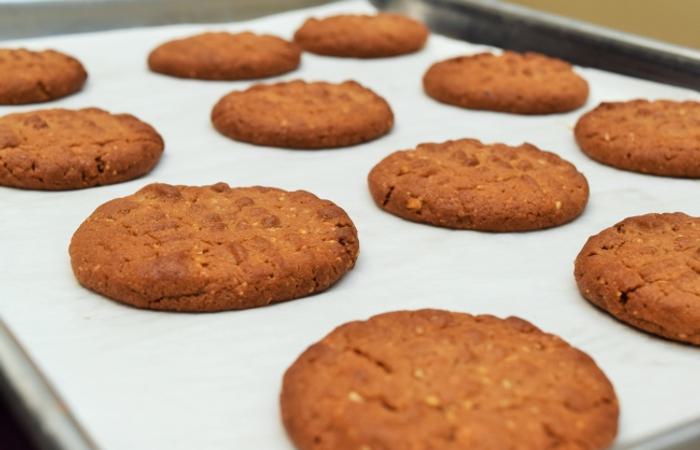
Crickets: The Gateway Bug
One fine day in the test kitchen, we gathered around the table for yet another tasting. Some snack mixes and cookies, couldn’t be too bad could they? The cookies were great; nutty, golden brown peanut butter cookies with a delightfully sandy, crunchy texture. The snack mix though, upon closer inspection, appeared to have antennae, legs, and little eyes (!!) This wasn’t your average Chex Mix folks, these were roasted, seasoned crickets! And to our surprise, we actually liked them.
Over the next couple posts, we’ll be playing with edible insects in some fun snack and bakery applications. We’re honored to have been selected to participate in the Marx Foods Edible Insect Challenge and will be showcasing our entries in upcoming posts. *Please note, while we did receive free samples of products to formulate with, none of our posts are sponsored nor were we compensated in any way. All opinions and recipes are our own!
Snap, Crackle, Hop!
Entomophagy is the practice of eating insects. Insects have long been eaten in many cultures, but here in the US, it is a more recent trend due to insect’s high protein and low-maintenance, low-resource production.
The most popular insects being farmed and sold for human consumption in the US are crickets. Cricket farming is regulated by the USDA and there are organic and gluten-free sources available. Allergen warnings are often listed on insect containing products as there has been some connection between shellfish allergies and insect allergies.

Cricket Basics
Crickets are members of the Gryllidae family, and are somewhat related to grasshoppers and locust. Although there are over 900 species of crickets, the ones farmed for consumption are often called common of field crickets.
Raising crickets is a relatively simple operation. The crickets are housed in plastic troughs that can be stacked, each holding about 3,000 insects, requiring significantly less physical space than other sources of animal proteins. When they are ready to harvest, the crickets are subjected to low temperatures encouraging them to go into a natural physiological state of dormancy, called diapause. Once the insects are in this dormant state, they are then frozen completely before being further processed.
Further processing could include roasting and/or grinding to produce a fine or coarse ground flour, often marketed as cricket protein due to the high protein content. Whole roasted crickets are also available, in plain and flavored varieties with seasonings as a snack.
Sustainability
Farmed crickets are typically vegetarian fed and require very little water. For every 1 pound of edible crickets, only 0.5 gallon of water is needed, compared to the ~500 gallons per every 1 pound of beef; the environmental savings are apparent. The amount of feed is also significantly less for crickets; 10 pounds of feed would yield 5 pounds of crickets, but only 0.5 pounds of beef, 1 pound of pork or 2 pounds of chicken.
Nutrition
The nutritional profile of crickets, and other insects, is one other major reason for the increase in entomophagy. Being high in protein, iron and calcium, crickets are a unique source of nutrients with eco-friendly sourcing and a light carbon footprint.

Where to Find Edible Insects
Cricket and other insect based products can be found on the market by these brands:
Crickets in Formulation
Cricket flour is the most common form of crickets used in new product formulation and recipe development for the home cook, being more accessible to the average eater than whole crickets. Cricket flour/protein can be successfully substituted in baked goods like cookies, cakes and muffins at 10-20% of dry ingredients for a protein and nutrient boost. The flour can also be used in savory applications as a thickener in sauces and gravies.

Peanut Butter Chirp Cookies
These rich and nutty peanut butter cookies boast crispy edges and a chewy center. They’ve been taste tested and approved by unsuspecting panelists, and passed with flying colors!
Yield: 12 large or 24 small cookies
INGREDIENT | PERCENT (%) | WEIGHT (g) |
AP Flour | 18.87% | 125.00 |
Cricket Flour | 3.77% | 25.00 |
Baking Soda | 0.17% | 1.15 |
Baking Powder | 0.17% | 1.15 |
Sea Salt | 0.45% | 3.00 |
Butter, unsalted | 16.61% | 110.00 |
Brown Sugar, light | 16.61% | 110.00 |
Sugar, granulated | 15.10% | 100.00 |
Extra-Crunchy Peanut Butter | 19.63% | 130.00 |
Egg | 8.61% | 57.00 |
Vanilla extract | 0.63% | 4.20 |
Peanuts, salted, roasted | 15.10% | 100.00 |
Total | 100.00% | 662.30 |
Method of Production:
- Preheat convection oven to 325F.
- Chop peanuts finely until resembling breadcrumbs.
- Combine dry ingredients (except peanuts) until evenly distributed.
- Cream butter and sugars ~3 minutes in stand mixer. Add peanut butter and mix until completely combined. Add egg and vanilla.
- Stir in dry ingredients. Stir in peanuts.
- Roll 1 or 2 tablespoon portions of dough (depending on how big you like your cookies) into 2-inch balls. Space ~2.5 inches apart on greased or parchment-lined cookie sheet. Press with fork dipped in water for a crisscross design.
- Bake 10-12 minutes rotating sheet halfway through bake time. Cool completely.








